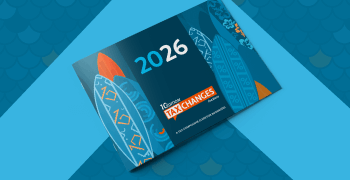
Avalara Tax Changes 2022: Global tax trends
With global ecommerce on track to surpass $7 trillion by 2025, new markets and opportunities await entrepreneurial businesses. Yet the rise in cross-border shipments has strained a supply chain already stressed by the COVID-19 pandemic. And while global sellers strive to meet customer demand, they also have to navigate a raft of complicated cross-border compliance requirements.
Some of the issues affecting global businesses and tax compliance in 2022 include electronic invoicing mandates and the digitalizing of tax administration, updates to the harmonized commodity and coding system, and new or ongoing COVID-19 relief efforts. Read on for more details.
Electronic invoicing mandates becoming more prevalent and stringent
As part of an ongoing battle to reduce tax gaps and improve tax compliance, countries worldwide are moving forward with a host of new digitalization mandates in 2022. These include electronic invoicing requirements as well as a new compulsory VAT reverse charge in France, mandatory QR codes on all invoices in Portugal, and real-time B2B e-invoicing requirements in Spain.
Other policy changes include:
- A new B2B e-invoicing mandate in Germany
- A new format for VAT returns in Norway
- A new National System of e-Invoices in Poland
- E-invoicing mandates for B2B cross-border transactions in Italy
- A new e-invoicing system in Saudi Arabia
- Making Tax more Digital in the U.K.
- Mandatory e-invoicing in Vietnam
Some of the above changes are being adopted nationwide from the outset; others will be phased in. For example, e-invoicing requirements in Vietnam will be implemented in six cities and provinces through March 2022, and in another 57 cities and provinces April through July 2022. From July 1, 2022, electronic invoicing will be mandatory for all B2B sales in Vietnam.
Alex Baulf, senior director of global indirect tax at Avalara, encourages businesses to “think strategically rather than tactically” when considering how to comply with new e-invoicing requirements. A key consideration should be whether an e-invoicing solution can be scaled across countries and regions.
Digitalization: Ongoing EU and U.K. VAT reform
As individual countries move forward with their own digitalization requirements, the European Commission is developing a more holistic “VAT in the Digital Age” initiative. A draft proposal is expected sometime this month. Baulf says there will likely be three major focus areas related to digitalization, VAT, and evolving business models and technologies:
- A single EU-wide registration
- Digital Reporting Requirements (DRR) and e-invoicing
- VAT treatment of the platform economy
Feedback obtained from approximately 160 advisors, business leaders, government officials and association representatives in October 2021 indicates there’s support for these measures. That the current system isn’t working — each member state implements their own digital reporting and invoicing requirements — is widely recognized. So is the fact that transitioning from separate registration requirements for each member state to an EU-wide model will be challenging.
The EU recognizes the VAT gap is due, in large part, to ineffective enforcement measures. It also knows digitalization can help reduce compliance costs as well as the tax gap. Nonetheless, there will be growing pains.
New digitization policies, once adopted, could take effect as early as 2023. In the meantime, tax administrators and businesses throughout the EU are continuing to adapt to the One-Stop Shop (OSS) and Import One-Stop Shop (IOSS) regimes, and to the fact that marketplaces are now the deemed supplier liable for tax.
HS 2022 rollout
Another challenge facing many businesses this year is the January 1, 2022, release of the seventh edition of the Harmonized System (HS) by the World Customs Organization (WCO), which is updated every five years. More than 200 countries use HS codes to identify and track cross-border sales.
HS codes are difficult to get right, no matter what you sell or where you sell it. Though six digits is the global standard, every country adds additional digits to distinguish each product. When the codes change, getting them right gets harder — and many changed on January 1, 2022 with the launch of HS 2022.
Some countries have already made the necessary changes. For one reason or another, others will wait. This will compound compliance challenges for businesses in 2022 and beyond.
COVID-19 relief initiatives
Although many COVID-19 emergency relief measures have started to expire or will be winding down soon, those still in effect can be helpful:
- EU member states may apply a reduced VAT rate to testing kits and more through 2022
- Austria’s COVID-19 Tax Amendment Act runs through December 2022
- Estonia has reduced excise duties through April 2022
- Germany’s reduced VAT rate for testing kits, as well as restaurant and catering services, runs through 2022
- Iceland has suspended the bed-night tax until February 2022
- The U.K. reduced some VAT rates and deferred certain VAT payments until the end of March 2022
With the advent of the omicron variant, businesses should be alert to new relief measures, including filing and payment extensions and reduced rates.
Other issues affecting global tax in 2022
The above just scratches the surface of global commerce and international tax compliance. Other issues include the growing gig economy and a call for carbon-neutral delivery options. In addition, supply chain issues will likely persist, which could compel businesses to develop new suppliers closer to home.
Learn more about the issues affecting global tax compliance in the global tax section of Avalara Tax Changes 2022.

Avalara Tax Changes 2026 is here
The 10th edition of our annual report engagingly breaks down key policies related to sales tax, tariffs, and VAT.
Stay up to date
Sign up for our free newsletter and stay up to date with the latest tax news.














